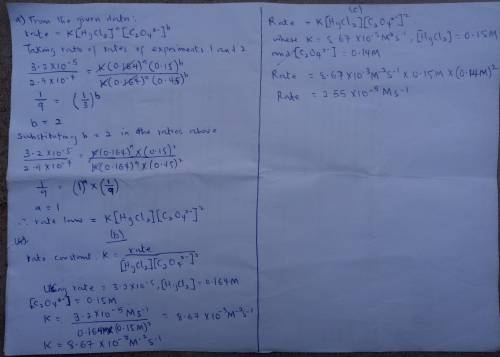
Chemistry, 25.09.2020 01:01, 22chandlerlashley
Consider the following reaction between mercury(II) chloride and oxalate ion.
2 HgCl2(aq) + C2O42-(aq) 2 Cl -(aq) + 2 CO2(g) + Hg2Cl2(s)
The initial rate of this reaction was determined for several concentrations of HgCl2 and C2O42-, and the following rate data were obtained for the rate of disappearance of C2O42-.
Experiment [HgCl2] (M) [C2O42-] (M) Rate (M/s)
1 0.164 0.15 3.2 10-5
2 0.164 0.45 2.9 10-4
3 0.082 0.45 1.4 10-4
4 0.246 0.15 4.8 10-5
(a) What is the rate law for this reaction?
k[HgCl2]2[C2O4-2]
k[HgCl2]2[C2O4-2]1/2
k[HgCl2][C2O4-2]2
(b) What is the value of the rate constant?
M-2s-1
(c) What is the reaction rate when the concentration of HgCl2 is 0.15 M and that of C2O42- is 0.14 M if the temperature is the same as that used to obtain the data shown above?
M/s

Answers: 1
Other questions on the subject: Chemistry

Chemistry, 22.06.2019 04:30, homeschool0123
How many moles of air are there in a human lung with a volume of 2.4 l at stp? explain your answer
Answers: 1

Chemistry, 22.06.2019 06:30, coreyslotte
Use examples from the article to explain one positive and one negative effect that chemistry has had on society.
Answers: 2


Chemistry, 22.06.2019 14:30, hjlhdjfhjh
How does a noncompetitive inhibitor reduce an enzyme’s activity?
Answers: 1
Do you know the correct answer?
Consider the following reaction between mercury(II) chloride and oxalate ion.
2 HgCl2(aq) + C2O42-(...
Questions in other subjects:







Mathematics, 16.01.2020 01:31



English, 16.01.2020 01:31







